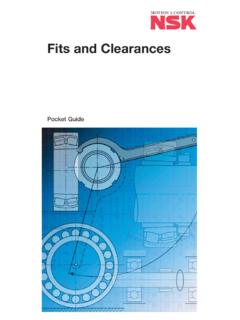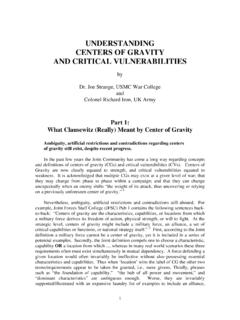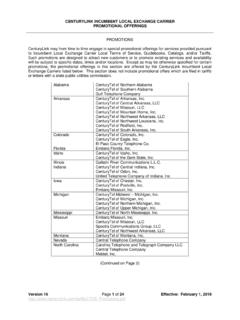Transcription of PANTM Hi Performance Compressor Manifolds
1 PANTM Hi Performance Compressor Manifolds Major efficiency gains achieved by adapting high Performance engine technology to reciprocating compressors. _____ A whitepaper published jointly by ACI Services Inc. and OPTIMUM Pumping Technology Rev. 0 Issued June 14, 2016 _____ INTRODUCTION Since 2006, ACI Services Inc. (ACI) and OPTIMUM Pumping Technology (OPT) have been collaborating to develop and apply finite amplitude unsteady gas dynamic wave modeling technology to reciprocating gas compressors4. This quickly led to inventing several new patent pending devices that the companies termed PANTM . The first prototype used tuned loops to create a very efficient filter, called a Pulsation Attenuation Network, that cancelled pulsations with little or no pressure drop penalty.
2 This evolved into a product that is now called a PANTM Filter. With further research and development, beginning in 2008, the companies created tuned Compressor Manifolds . These are similar to high Performance engine intake and exhaust Manifolds , which provided a boost to Compressor Performance in the form of lower specific power (BHP/MMSCFD) and/or more flow for the same power input. This device was referred to as a Performance Augmentation Network. It provides pulsation cancellation similar to the PANTM Filter, but goes much further by interleaving cylinder pulsations and timing the reflection of pressure waves back to the Compressor cylinder suction and discharge valves during the time that they are open.
3 With careful optimization, it controls line side pulsations while simultaneously reducing the required adiabatic work and power and/or increasing the cylinder s mass flow rate or capacity9,10. This technology has evolved into a product that is now called a PANTM Hi Performance Compressor Manifold. The technology behind these products is explained in more detail in The Theory of PANTM Systems15. OPT s development of finite amplitude wave simulation and design technology for reciprocating engines dates back to 1994 with work that they sponsored at The Queens University of Belfast (QUB). In 2005, at the encouragement of a well known Compressor reliability engineer, Randall R.
4 Raymer, OPT started to model reciprocating Compressor cylinders and their connected piping systems. This soon led to collaboration with ACI to leverage that company s considerable reciprocating Compressor optimization experience. VALIDATION OF PANTM TECHNOLOGY FOR PULSATION CONTROL AND Performance ENHANCEMENT The pressure drop and power penalties that can occur with conventional volume choke volume and restrictive orifice pulsation control methods on high speed reciprocating compressors has been well documented, especially at high flows and low pressure ratios1,2. Many years of significant developmental effort resulted in OPT s Virtual Pumping Station (VPSTM) software, which is a robust modelling and design tool that uses accurate real gas thermodynamic properties.
5 The use of this system to design and model several large existing single stage reciprocating Compressor systems showed the potential for double digit improvements in Compressor efficiency and specific power (BHP/MMSCFD). For example, simulations in 2011 showed that a PAN Hi Performance Compressor Manifold would reduce the BHP/MMSCFD by an average of 12% across a speed range of 580 to 720 on a 6 throw 8000 HP Compressor operating at a design pressure ratio of , including a 15% reduction at the 720 rpm rated speed9,10. Among the best improvements predicted from several extensive investigations of optimized PAN Manifolds potentially applied to existing compressors was a 31% BHP/MMSCFD reduction at a pressure ratio on a 4800 HP, 1000 rpm 6 throw, single stage Compressor .
6 Laboratory Testing Prior to full scale field testing of PAN technology, laboratory tests were conducted to validate the pulsation cancellation predicted by VPS simulations of a Compressor test rig. In 2008 an industrial Compressor rig was configured as two double acting 4 in. bore diameter x 3 in. stroke cylinders operating in parallel. A PAN Filter was designed and fabricated for the discharge side of this Compressor and tests were conducted from 700 to 1050 rpm using atmospheric air5. With a straight pipe and no pulsation control system, the pulsation was highest at 850 rpm and 35 psig discharge pressure. Replacement of the straight pipe with a single loop PAN Filter showed a pulsation reduction of at that condition.
7 The PAN Filter accomplished this with a pressure drop that was only higher than what was measured with the straight pipe. Further experimentation with a PAN Filter having two loops in series showed a pulsation reduction at the same operating condition, with a pressure drop penalty of only The testing further confirmed that the two loop PAN filter effectively controlled pulsations as well as an orifice plate over the full speed range of 700 to 1050 rpm, while having much less pressure drop penalty than the orifice plate. First Proof of Concept Field Experience Following successful laboratory results, collaboration with a major gas transmission company led to installation of a proof of concept PAN system on a Compressor at a gas storage site in Northern Central Pennsylvania in 20096,7,8.
8 Due to limited space and budget, a PAN was designed and retrofitted to the discharge of one side of a 4 throw, single stage Superior MH64 Compressor having in. cylinders. The 6 in. stroke Compressor operated from 750 to 1000 rpm and the existing system employ ed a volume choke volume pulsation con trol system that also included multiple orifice plates. At low pressure ratios, pressure drop in the existing system was excessive, but at high pressure ratios, the pulsation control was not sufficiently effective over at least some of the operating range. Figure 1: Proof of concept PAN system installed on discharge of one two throw side of a field Compressor in 2009. The primary objective of the PAN system was to eliminate the excessive pressure drop associated with effective pulsation control.
9 The resulting PAN system for this application combined a simple early version of a PAN Manifold and a two loop PAN Filter operating in series as shown in Figure 1. The end user s requirement to minimize changes to the package skid and to make the PAN system removable in case it did not meet expectations led to mounting the PAN Filter in a stacked arrangement in a pre fabricated steel frame that was lagged to a 4 in. thick concrete floor, , no foundation under it, as shown in Figure 2. Removal of the existing bottles and install ation of the PAN system, including grouting under the PAN frame, was accomplished in less than five days. During the field testing, gas conditions permitted opera tion with various load steps over a speed range of 860 to Figure 2: Proof of concept PAN installation and measurement locations.
10 1000 rpm. Figure 3 summarizes the effectiveness of the PAN Manifold and the combined effects of the PAN Manifold and two loop PAN Filter at an average discharge pressure of 886 psig and a constant pressure ratio of The very simple PAN Manifold, by itself, reduced pulsations by 47 to 79% over the speed range. Addition of the PAN Filter in series further reduced pulsations by 88 to 93% over the speed range, which equates to pulsation levels of only to of discharge line pressure. This test data confirmed the simulation predictions that a properly designed PAN system effectively controls pulsations over a wide range of operating speeds. Speed (rpm) Pulsation at Compressor Discharge Flange (P/P psi) Pulsation after Manifold PAN Y Junction (P/P psi) Pulsation Reduction after PAN Manifold Y Junction (%) Pulsation after PAN Filter (P/P psi) Total Pulsation Reduction (%) Pulsation % of Line Pressure 860 79 90 900 47 93 950 66 91 980 53 89 1000 53 88 Figure 3: Proof of concept discharge PAN pulsation measurements at 886 psig average discharge pressure and pressure ratio.







